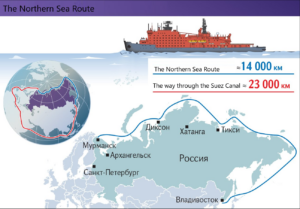
The planned indicator of the federal project “Development of the NSR” has been exceeded by 12%
By the end of 2023, the capacity of Russian ports within the borders of the Northern Sea Route (NSR, Sevmorput) increased to 40.5 million tons, which exceeds the planned figure laid down in the federal project “Development of the NSR” (the project provides for 36 million tons). Maxim Kulinko, Deputy Director of the Directorate of the Northern Sea Route of the Rosatom State Corporation, administrator of the federal project “Development of the NSR”, told IA PortNews about this.
He explained that last year, “The Department of Project Implementation of the NSR, together with the Federal State Unitary Enterprise Hydrographic Enterprise, carried out tremendous work on the construction and commissioning of federal property facilities, 43 billion rubles of budget money were spent.”
The most important projects that made it possible to fulfill the indicators of the federal project “Development of the NSR” by 100% were the work at the Utrenny terminal (PJSC NOVATEK) and the provision of wiring of the gravity type base (OGT) with a displacement of over 600 thousand tons along the Sea Channel of the Gulf of Ob. “In a short time, over 3 years, federal—owned facilities of the Utrenny terminal worth 100 billion rubles were built and put into operation,” Maxim Kulinko said.
The interlocutor of PortNews IAA emphasized that in the conditions of sanctions pressure and a shortage of dredging fleet in Russia, “a foreign technological partner was found.” As a result, three powerful dredging vessels were mobilized on the Northern Sea Route: two vessels with a capacity of 11 thousand cubic meters each. m and one — 1 thousand cubic meters. m. In 45 days, 4.5 million cubic meters of soil were withdrawn from the Sea Channel of the Gulf of Ob, which made it possible to ensure the wiring of the OGT in due time.
“We did not allow the deadlines for the implementation of NOVATEK’s most important investment project to be violated. In addition, this project makes a huge contribution to the work to achieve the goal of Russia’s conquest of 20% of the global liquefied natural gas market,” Maxim Kulinko stressed.
Recall that in the summer of 2023, OGT-1, the first LNG production line with a capacity of 6.6 million tons, was towed by sea from the Center for the Construction of Large-capacity Offshore Structures (CSCMS) in the Murmansk Region to the Gydan Peninsula and installed on a prepared marine base in the coastal zone. The offshore operation to tow the platform was completed in 22 days. The platform has a weight of 640 thousand tons and is the heaviest movable object in the history of the global LNG industry. Its length is 330 m, width — 152 m, height — 90 m.
In total, for the Arctic LNG 2 project, PJSC NOVATEK provides for the construction of three such lines with a total capacity of 19.8 million tons per year and stable gas condensate up to 1.6 million tons per year. The launch of the second and third lines is planned in 2024 and 2026, respectively.
The construction of the Utrenny terminal (site No. 2 of the Sabetta Seaport), including federal property facilities, as well as the reconstruction of the Marine Canal are included in the Comprehensive Plan for the Modernization and Expansion of the Mainline Infrastructure (KPMI) for the period up to 2024. The approach channel to the terminal with a length of 5.6 km and a width of 510 m will ensure navigation in conditions of soldered and drifting ice. The cost of the LNG terminal is 95.7 billion rubles, the project is 70% funded by the state budget of the Russian Federation.
We also add that according to the passport of the federal project “Development of the Northern Sea Route”, the total capacity of seaports along the Arctic route is planned to increase from 32 to 83 million tons per year by 2025, and the volume of traffic to 80 million tons per year.
Original:Портовые мощности на Севморпути по итогам 2023 года выросли до 40,5 млн тонн (portnews.ru)